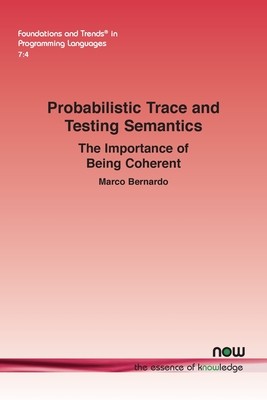
- We will send in 10–14 business days.
- Author: Marco Bernardo
- Publisher: Now Publishers
- Year: 2022
- ISBN-10: 1638280746
- ISBN-13: 9781638280743
- Format: 15.6 x 23.4 x 0.6 cm, minkšti viršeliai
- Language: English
- SAVE -10% with code: EXTRA
Reviews
Description
In this monograph, the author focuses on trace and testing semantics for nondeterministic and probabilistic processes represented by simple probabilistic automata. A trace is a sequence of activities labeling a sequence of transitions performed by a process, thus abstracting from branching points in the process behavior. A test is formalized as a nondeterministic and probabilistic process extended with success states or success actions, which is run in parallel with the process under test thus resulting in an interaction or testing system.
Written as a comprehensive review of the topic, the author introduces the reader to the concept of nondeterministic and probabilistic models and how nondeterminism can be resolved. The author then considers probabilistic models, three anomalies of these models and how to overcome them. The author then addresses alternative characterizations of the two probabilistic trace equivalences. Finally, the author considers the anomalies of probabilistic testing equivalence and how to avoid them. This monograph is aimed at researchers working on the formal method aspects of programming languages.EXTRA 10 % discount with code: EXTRA
The promotion ends in 21d.07:24:30
The discount code is valid when purchasing from 10 €. Discounts do not stack.
- Author: Marco Bernardo
- Publisher: Now Publishers
- Year: 2022
- ISBN-10: 1638280746
- ISBN-13: 9781638280743
- Format: 15.6 x 23.4 x 0.6 cm, minkšti viršeliai
- Language: English English
In this monograph, the author focuses on trace and testing semantics for nondeterministic and probabilistic processes represented by simple probabilistic automata. A trace is a sequence of activities labeling a sequence of transitions performed by a process, thus abstracting from branching points in the process behavior. A test is formalized as a nondeterministic and probabilistic process extended with success states or success actions, which is run in parallel with the process under test thus resulting in an interaction or testing system.
Written as a comprehensive review of the topic, the author introduces the reader to the concept of nondeterministic and probabilistic models and how nondeterminism can be resolved. The author then considers probabilistic models, three anomalies of these models and how to overcome them. The author then addresses alternative characterizations of the two probabilistic trace equivalences. Finally, the author considers the anomalies of probabilistic testing equivalence and how to avoid them. This monograph is aimed at researchers working on the formal method aspects of programming languages.

Reviews